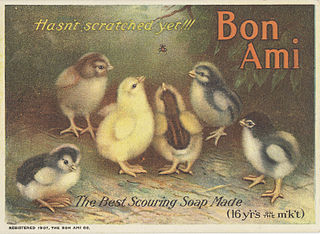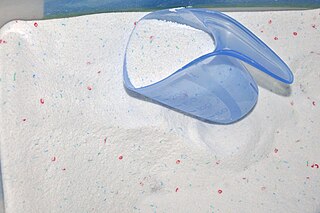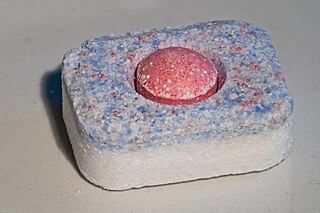Related Research Articles

A detergent is a surfactant or a mixture of surfactants with cleansing properties when in dilute solutions. There are a large variety of detergents, a common family being the alkylbenzene sulfonates, which are soap-like compounds that are more soluble in hard water, because the polar sulfonate is less likely than the polar carboxylate to bind to calcium and other ions found in hard water.

Sodium bicarbonate (IUPAC name: sodium hydrogencarbonate), commonly known as baking soda or bicarbonate of soda, is a chemical compound with the formula NaHCO3. It is a salt composed of a sodium cation (Na+) and a bicarbonate anion (HCO3−). Sodium bicarbonate is a white solid that is crystalline but often appears as a fine powder. It has a slightly salty, alkaline taste resembling that of washing soda (sodium carbonate). The natural mineral form is nahcolite, although it is more commonly found as a component of the mineral trona.

Sodium carbonate is the inorganic compound with the formula Na2CO3 and its various hydrates. All forms are white, odourless, water-soluble salts that yield alkaline solutions in water. Historically, it was extracted from the ashes of plants grown in sodium-rich soils, and because the ashes of these sodium-rich plants were noticeably different from ashes of wood, sodium carbonate became known as "soda ash". It is produced in large quantities from sodium chloride and limestone by the Solvay process, as well as by carbonating sodium hydroxide which is made using the chloralkali process.
Sodium silicate is a generic name for chemical compounds with the formula Na
2xSi
yO
2y+x or (Na
2O)
x·(SiO
2)
y, such as sodium metasilicate, sodium orthosilicate, and sodium pyrosilicate. The anions are often polymeric. These compounds are generally colorless transparent solids or white powders, and soluble in water in various amounts.

Trisodium phosphate (TSP) is an inorganic compound with the chemical formula Na3PO4. It is a white, granular or crystalline solid, highly soluble in water, producing an alkaline solution. TSP is used as a cleaning agent, builder, lubricant, food additive, stain remover, and degreaser.
An abrasive is a material, often a mineral, that is used to shape or finish a workpiece through rubbing which leads to part of the workpiece being worn away by friction. While finishing a material often means polishing it to gain a smooth, reflective surface, the process can also involve roughening as in satin, matte or beaded finishes. In short, the ceramics which are used to cut, grind and polish other softer materials are known as abrasives.

Persil is a German brand of laundry detergent manufactured and marketed by Henkel around the world except in the United Kingdom, Ireland, France, Latin America, China, Australia and New Zealand, where it is manufactured and marketed by Unilever. Persil was introduced in 1907 by Henkel. It was the first commercially available laundry detergent that combined bleach with the detergent. The name was derived from two of its original ingredients, sodium perborate and sodium silicate.

Bon Ami is an American scouring powder brand sold by the Bon Ami Company of Kansas City, Missouri. Since its inception in the late 19th century, the brand's advertising campaigns have gained particular notice.

Ajax is an American brand of household cleaning products and detergents made by Colgate-Palmolive and Awesome Products Inc.

Laundry detergent is a type of detergent used for cleaning dirty laundry (clothes). Laundry detergent is manufactured in powder and liquid form.

Dishwashing liquid, also known as dishwashing soap, dish detergent, or dish soap, is a detergent used in dishwashing. Dishwashing detergent for dishwashers comes in various forms such as cartridges, gels, liquids, packs, powder, and tablets. It is usually a highly-foamy mixture of surfactants with low skin irritation that consumers primarily use for washing glasses, plates, cutleries, and cooking utensils. In addition to its primary use, dishwashing liquid is also used for various informal applications, like creating bubbles, clothes washing, and cleaning birds affected by oil spills.

Carpet cleaning is performed to remove stains, dirt, debris, and allergens from carpets. Common methods include hot water extraction, dry-cleaning, and vacuuming.

Cleaning agents or hard-surface cleaners are substances used to remove dirt, including dust, stains, foul odors, and clutter on surfaces. Purposes of cleaning agents include health, beauty, removing offensive odors, and avoiding the spread of dirt and contaminants to oneself and others. Some cleaning agents can kill bacteria and clean at the same time. Others, called degreasers, contain organic solvents to help dissolve oils and fats.
Stain removal is the process of removing a mark or spot left by one substance on a specific surface like a fabric. A solvent or detergent is generally used to conduct stain removal and many of these are available over the counter.
Wet Processing Engineering is one of the major streams in Textile Engineering or Textile manufacturing which refers to the engineering of textile chemical processes and associated applied science. The other three streams in textile engineering are yarn engineering, fabric engineering, and apparel engineering. The processes of this stream are involved or carried out in an aqueous stage. Hence, it is called a wet process which usually covers pre-treatment, dyeing, printing, and finishing.

Lestoil is a registered trade name of Clorox for a heavy-duty multipurpose cleanser product, used to remove extremely difficult laundry stains, dissolve water-based and oil-based paints, and clean grease, oil, paint, and adhesives from floors and surfaces. It was introduced as a dry cleaning fluid for laundry in 1933. As a company, Lestoil, also known as the Adell Chemical Company, also made Bon Ami, from 1964 until 1971.

Dishwasher detergent is a detergent made for washing dishes in a dishwasher. Dishwasher detergent is different from dishwashing liquid made to wash dishes by hand.

Fabric treatments are processes that make fabric softer, or water resistant, or enhance dye penetration after they are woven. Fabric treatments get applied when the textile itself cannot add other properties. Treatments include, scrim, foam lamination, fabric protector or stain repellent, anti microbial and flame retardant.

Scouring is a preparatory treatment of certain textile materials. Scouring removes soluble and insoluble impurities found in textiles as natural, added and adventitious impurities: for example, oils, waxes, fats, vegetable matter, as well as dirt. Removing these contaminants through scouring prepares the textiles for subsequent processes such as bleaching and dyeing. Though a general term, "scouring" is most often used for wool. In cotton, it is synonymously called "boiling out", and in silk, and "boiling off.
References
- 1 2 3 4 5 6 John Toedt, Darrell Koza, and Kathleen Van Cleef-Toedt (2005): Chemical Composition of Everyday Products . Greenwood Publishing; 205 pages. ISBN 9780313325793
- ↑ Room, Adrian (1983). Dictionary of Trade Name Origins . Routledge. pp. 184. ISBN 0-7102-0174-5.